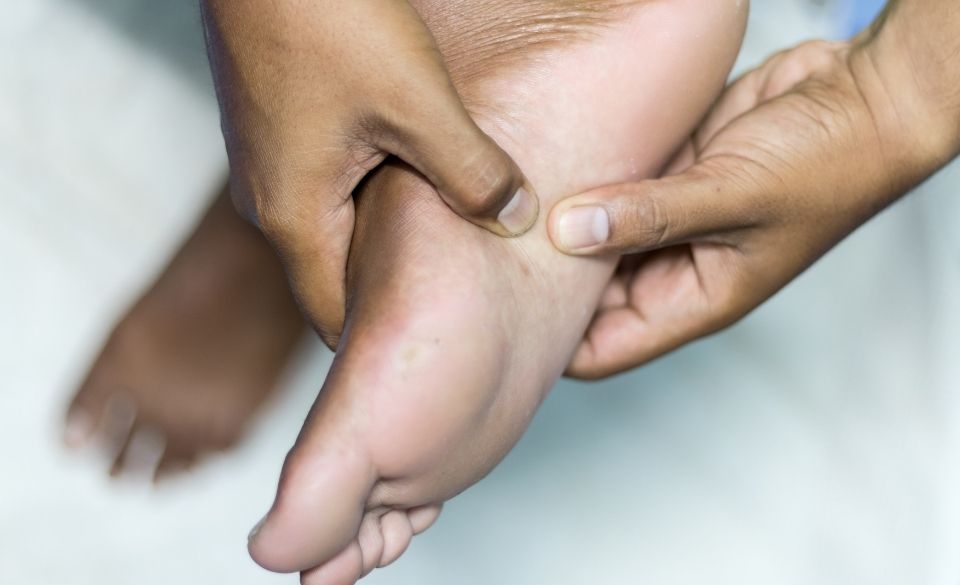
How To Prevent Plantar Fasciitis – Recovery, Prevention & Stretches
Page Contents
Most runners have experienced symptoms of plantar fasciitis once in their lifetime. It is one of the most common injuries within runners, and one of the most well-known injuries to cause heel pain.
With that being said. More people want to know more about the injury and how to prevent plantar fasciitis, which can put them out of running for weeks or even months.
In this article, we discuss the cause, rehabilitation, and how to prevent plantar fasciitis from happening. So, keep reading to learn more.
What is Plantar Fasciitis?
If you haven’t heard of this injury before, you may be wondering what is plantar fasciitis is?
Plantar fasciitis is the inflammation of the tissue along the bottom of each foot. This tissue connects the heel bone to the toes and runs across the bottom of the feet.
When inflamed, it can cause stabbing pain. This is usually felt first thing in the morning. It then typically starts to reside as your feet move more. However, if you are standing for long periods or even running, it can return much worse.
Unfortunately, the cause of plantar fasciitis is not well understood. However, overweight people or runners are more susceptible to this injury.
What Causes Plantar Fasciitis?
Now you may wonder what causes plantar fasciitis?
The most common cause of this injury is tension and stress placed on the tissue under the foot. This can be from incorrect shoes, high mileage, or even foot mechanics and age.
Flat feet, a high arch are common causes that can aggravate the plantar fascia. As well as obesity, which ends up putting added stress on the plantar fascia.
Other causes are occupations that require long periods on your feet. Such as factory workers, retail employees, and even teachers.
However, it has been well documented that runners suffer from plantar fasciitis often. This is mainly because of the mileage runners do each week, without added recovery. If you pair the mileage with incorrect footwear, it can inflame the plantar fascia relatively quickly.
Since tension and stress on the fascia can cause stress. Repeated stretching and impact can cause small tears, and irritate and inflame it more.
However, other factors that cause this aren’t widely studied as of yet.
Other risk factors that can cause symptoms of plantar fasciitis include age ( 40-60 years) and certain types of exercise (ballet, dancing, football, etc).
There can be some complications if you are struggling with this injury too. Ignoring this injury can result in stress on other parts of the foot. Continuing to walk, or run while injured can result in hip and back problems. So, it is important to allow adequate recovery time if you are trying to recover from this injury.

How To Prevent Plantar Fasciitis?
Luckily there are ways how to prevent plantar fasciitis. This includes:
Maintaining a healthy weight. Doing so will help reduce the stress and weight on the plantar fascia.
Choose the correct shoes. That means shoes with adequate support and cushioning that fits your running style.
Replace your running shoes regularly. Most running shoes have a limited lifespan. This largely depends on your weight, running style, and mileage. Either way, replacing your shoes regularly or even rotating your running shoes, can help keep the cushioning doing the correct job.
Ice regularly. If you struggle with inflammation under the foot, try to ice that area regularly. This can involve icing the feet 3 to 4 times a day for up to 15 minutes. Doing so will help reduce inflammation.
Regular stretching and massage. Regular stretching of the plantar fascia can help prevent symptoms from arising. It is important not to forget about the Achilles tendon and calf muscles too. Alternatively, self-massage can help prevent symptoms from happening in the future.

Running Stretches For Plantar Fasciitis
While stretching may help, it is more of a prevention. Regular stretching can help prevent plantar fasciitis from happening.
A visit to a physical therapist can help show you exercise to stretch the plantar fascia, as well as the Achilles tendon. If you are experiencing pain, they may even teach you how to correctly strap your foot, as this will help prevent excess stress on it.
However, there are some simple running stretches for plantar fasciitis. These can help relieve symptoms and promote recovery. These include:
Heel Raises
1. Start by standing on the balls of your feet on the edge of a step.
2. Slowly lower your heels off the corner of the step.
3. Once you have just passed the edge of the step so your heel is below it, begin raising your heel back up onto the balls of your feet.
4. Repeat this exercise up to 10 times on each foot.
5. Then repeat this again so you have two complete sets of heel raises.
Towel Scrunches
1. Start by sitting upright on a chair, with a towel under your feet.
2. Start by curling your toes. this should naturally pull the towel towards you.
3. Repeat this exercise up to 10 times on each foot.
4. Make sure your foot stays on the ground the entire time.
Wall Calf Stretch
1. Start by standing upright and facing a wall.
2. Place your hands flat against the wall and then extend one leg backward.
3. Bend your front leg until you feel a stretch in the calf muscle of your back leg.
4. To get more stretch of the calf muscle, push harder against the wall and bend your leading leg slightly lower.
5. Hold this stretch for 15-20 seconds and repeat up to 5 times per leg.
Other Procedures to Help Recovery
If regular stretching, icing, and recovery are not helping the injury there are other procedures that can be taken. This includes:
– Injections
– Shock wave therapy
– Ultrasonic therapy
– Surgery
Different types of shock waves and ultrasonic therapy can help stimulate healing. Some studies have shown promising results in the healing of the tissue. However, in worse-case scenarios, you may need steroid medication. Steroid medication can help provide temporary pain relief. Although multiple injections can weaken your plantar fascia. So it is not widely recommended as a long-term solution.
Last but not least is surgery. Only small amounts of people need to go through surgery. However, if this is the case they will detach the plantar fascia from the heel bone. This is only recommended when pain is severe and all other outlets have been tried.



